Community Assessment of Aboriginal Women in Western Australia
VerifiedAdded on 2023/06/14
|14
|3008
|104
AI Summary
This study is about a community assessment of the aboriginal women in Western Australia. It focuses on the demography statistics, health issues, and social health determinants. It explores all findings and data with an aim to improve health in aboriginal communities.
Contribute Materials
Your contribution can guide someone’s learning journey. Share your
documents today.

Running head: Aboriginal women in Western Australia 1
Community assessment of Aboriginal women in Western Australia
Name
Professor
School
Date.
Community assessment of Aboriginal women in Western Australia
Name
Professor
School
Date.
Secure Best Marks with AI Grader
Need help grading? Try our AI Grader for instant feedback on your assignments.
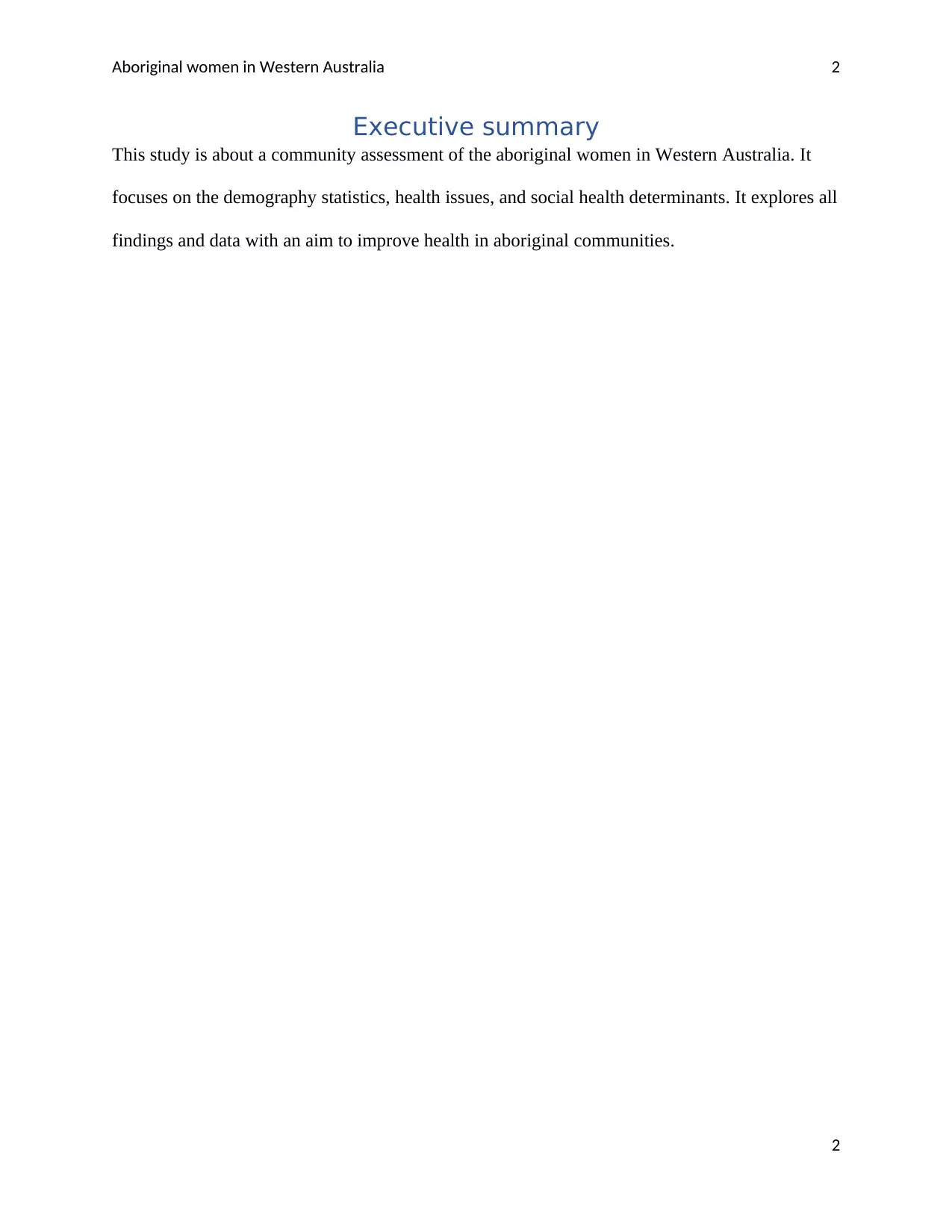
Aboriginal women in Western Australia 2
Executive summary
This study is about a community assessment of the aboriginal women in Western Australia. It
focuses on the demography statistics, health issues, and social health determinants. It explores all
findings and data with an aim to improve health in aboriginal communities.
2
Executive summary
This study is about a community assessment of the aboriginal women in Western Australia. It
focuses on the demography statistics, health issues, and social health determinants. It explores all
findings and data with an aim to improve health in aboriginal communities.
2

Aboriginal women in Western Australia 3
Contents
Executive summary.....................................................................................................................................2
Introduction.................................................................................................................................................3
Definition of terms..................................................................................................................................3
Demographics..............................................................................................................................................4
Health issues...............................................................................................................................................5
Social determinants of health......................................................................................................................7
Physical environment..............................................................................................................................7
Quality of health services in aboriginal areas..........................................................................................8
Individual behavior..................................................................................................................................8
Social environment......................................................................................................................................9
Conclusion...................................................................................................................................................9
References.................................................................................................................................................11
3
Contents
Executive summary.....................................................................................................................................2
Introduction.................................................................................................................................................3
Definition of terms..................................................................................................................................3
Demographics..............................................................................................................................................4
Health issues...............................................................................................................................................5
Social determinants of health......................................................................................................................7
Physical environment..............................................................................................................................7
Quality of health services in aboriginal areas..........................................................................................8
Individual behavior..................................................................................................................................8
Social environment......................................................................................................................................9
Conclusion...................................................................................................................................................9
References.................................................................................................................................................11
3
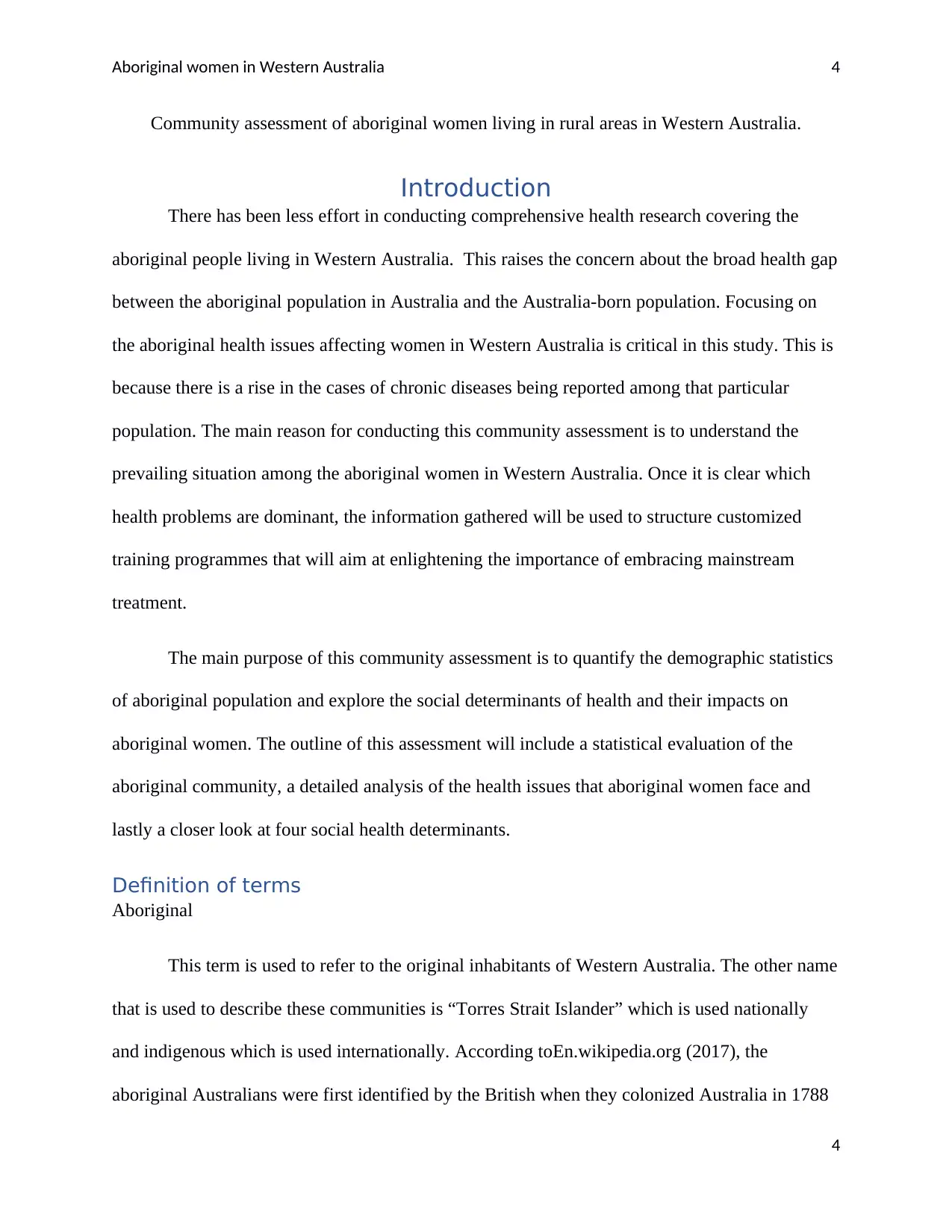
Aboriginal women in Western Australia 4
Community assessment of aboriginal women living in rural areas in Western Australia.
Introduction
There has been less effort in conducting comprehensive health research covering the
aboriginal people living in Western Australia. This raises the concern about the broad health gap
between the aboriginal population in Australia and the Australia-born population. Focusing on
the aboriginal health issues affecting women in Western Australia is critical in this study. This is
because there is a rise in the cases of chronic diseases being reported among that particular
population. The main reason for conducting this community assessment is to understand the
prevailing situation among the aboriginal women in Western Australia. Once it is clear which
health problems are dominant, the information gathered will be used to structure customized
training programmes that will aim at enlightening the importance of embracing mainstream
treatment.
The main purpose of this community assessment is to quantify the demographic statistics
of aboriginal population and explore the social determinants of health and their impacts on
aboriginal women. The outline of this assessment will include a statistical evaluation of the
aboriginal community, a detailed analysis of the health issues that aboriginal women face and
lastly a closer look at four social health determinants.
Definition of terms
Aboriginal
This term is used to refer to the original inhabitants of Western Australia. The other name
that is used to describe these communities is “Torres Strait Islander” which is used nationally
and indigenous which is used internationally. According toEn.wikipedia.org (2017), the
aboriginal Australians were first identified by the British when they colonized Australia in 1788
4
Community assessment of aboriginal women living in rural areas in Western Australia.
Introduction
There has been less effort in conducting comprehensive health research covering the
aboriginal people living in Western Australia. This raises the concern about the broad health gap
between the aboriginal population in Australia and the Australia-born population. Focusing on
the aboriginal health issues affecting women in Western Australia is critical in this study. This is
because there is a rise in the cases of chronic diseases being reported among that particular
population. The main reason for conducting this community assessment is to understand the
prevailing situation among the aboriginal women in Western Australia. Once it is clear which
health problems are dominant, the information gathered will be used to structure customized
training programmes that will aim at enlightening the importance of embracing mainstream
treatment.
The main purpose of this community assessment is to quantify the demographic statistics
of aboriginal population and explore the social determinants of health and their impacts on
aboriginal women. The outline of this assessment will include a statistical evaluation of the
aboriginal community, a detailed analysis of the health issues that aboriginal women face and
lastly a closer look at four social health determinants.
Definition of terms
Aboriginal
This term is used to refer to the original inhabitants of Western Australia. The other name
that is used to describe these communities is “Torres Strait Islander” which is used nationally
and indigenous which is used internationally. According toEn.wikipedia.org (2017), the
aboriginal Australians were first identified by the British when they colonized Australia in 1788
4
Paraphrase This Document
Need a fresh take? Get an instant paraphrase of this document with our AI Paraphraser
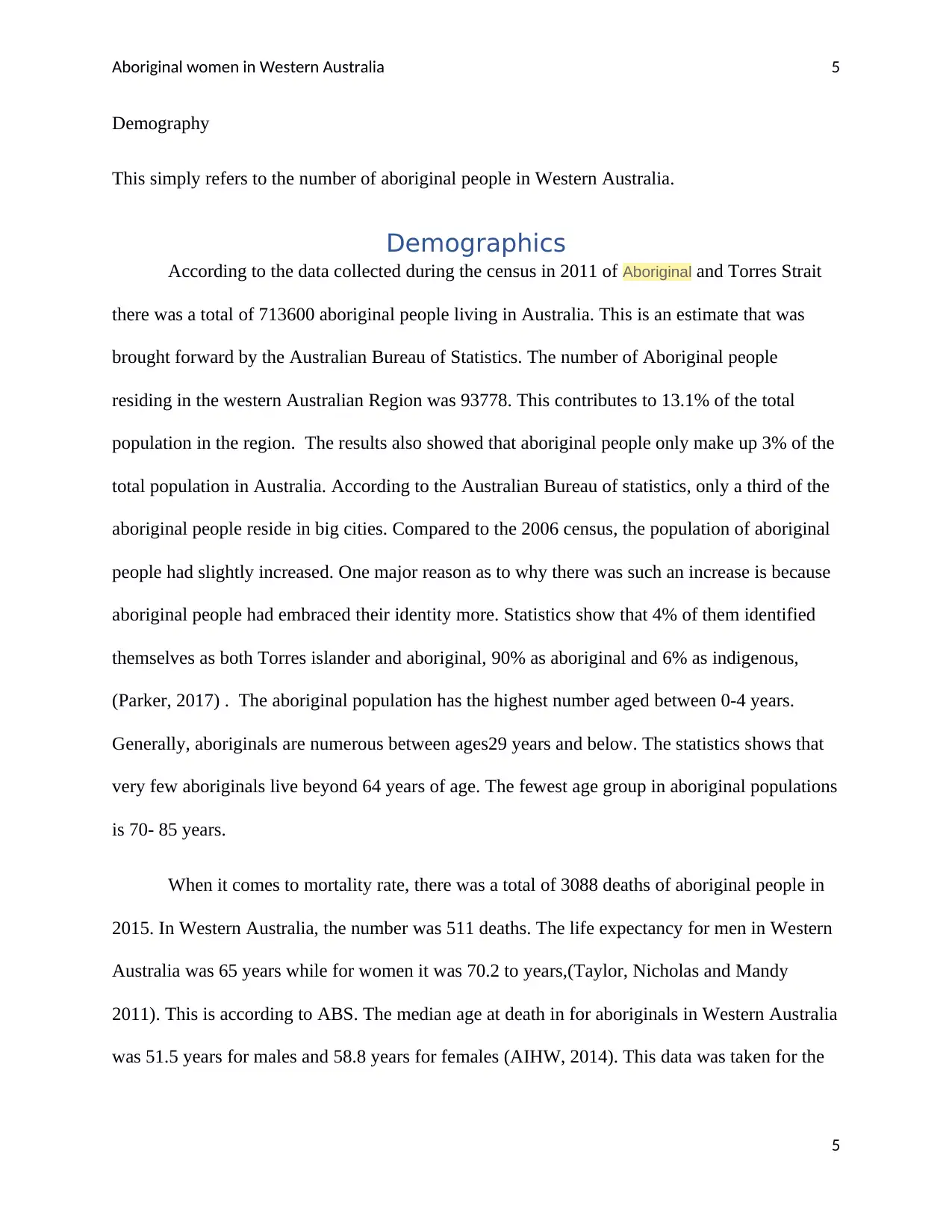
Aboriginal women in Western Australia 5
Demography
This simply refers to the number of aboriginal people in Western Australia.
Demographics
According to the data collected during the census in 2011 of Aboriginal and Torres Strait
there was a total of 713600 aboriginal people living in Australia. This is an estimate that was
brought forward by the Australian Bureau of Statistics. The number of Aboriginal people
residing in the western Australian Region was 93778. This contributes to 13.1% of the total
population in the region. The results also showed that aboriginal people only make up 3% of the
total population in Australia. According to the Australian Bureau of statistics, only a third of the
aboriginal people reside in big cities. Compared to the 2006 census, the population of aboriginal
people had slightly increased. One major reason as to why there was such an increase is because
aboriginal people had embraced their identity more. Statistics show that 4% of them identified
themselves as both Torres islander and aboriginal, 90% as aboriginal and 6% as indigenous,
(Parker, 2017) . The aboriginal population has the highest number aged between 0-4 years.
Generally, aboriginals are numerous between ages29 years and below. The statistics shows that
very few aboriginals live beyond 64 years of age. The fewest age group in aboriginal populations
is 70- 85 years.
When it comes to mortality rate, there was a total of 3088 deaths of aboriginal people in
2015. In Western Australia, the number was 511 deaths. The life expectancy for men in Western
Australia was 65 years while for women it was 70.2 to years,(Taylor, Nicholas and Mandy
2011). This is according to ABS. The median age at death in for aboriginals in Western Australia
was 51.5 years for males and 58.8 years for females (AIHW, 2014). This data was taken for the
5
Demography
This simply refers to the number of aboriginal people in Western Australia.
Demographics
According to the data collected during the census in 2011 of Aboriginal and Torres Strait
there was a total of 713600 aboriginal people living in Australia. This is an estimate that was
brought forward by the Australian Bureau of Statistics. The number of Aboriginal people
residing in the western Australian Region was 93778. This contributes to 13.1% of the total
population in the region. The results also showed that aboriginal people only make up 3% of the
total population in Australia. According to the Australian Bureau of statistics, only a third of the
aboriginal people reside in big cities. Compared to the 2006 census, the population of aboriginal
people had slightly increased. One major reason as to why there was such an increase is because
aboriginal people had embraced their identity more. Statistics show that 4% of them identified
themselves as both Torres islander and aboriginal, 90% as aboriginal and 6% as indigenous,
(Parker, 2017) . The aboriginal population has the highest number aged between 0-4 years.
Generally, aboriginals are numerous between ages29 years and below. The statistics shows that
very few aboriginals live beyond 64 years of age. The fewest age group in aboriginal populations
is 70- 85 years.
When it comes to mortality rate, there was a total of 3088 deaths of aboriginal people in
2015. In Western Australia, the number was 511 deaths. The life expectancy for men in Western
Australia was 65 years while for women it was 70.2 to years,(Taylor, Nicholas and Mandy
2011). This is according to ABS. The median age at death in for aboriginals in Western Australia
was 51.5 years for males and 58.8 years for females (AIHW, 2014). This data was taken for the
5
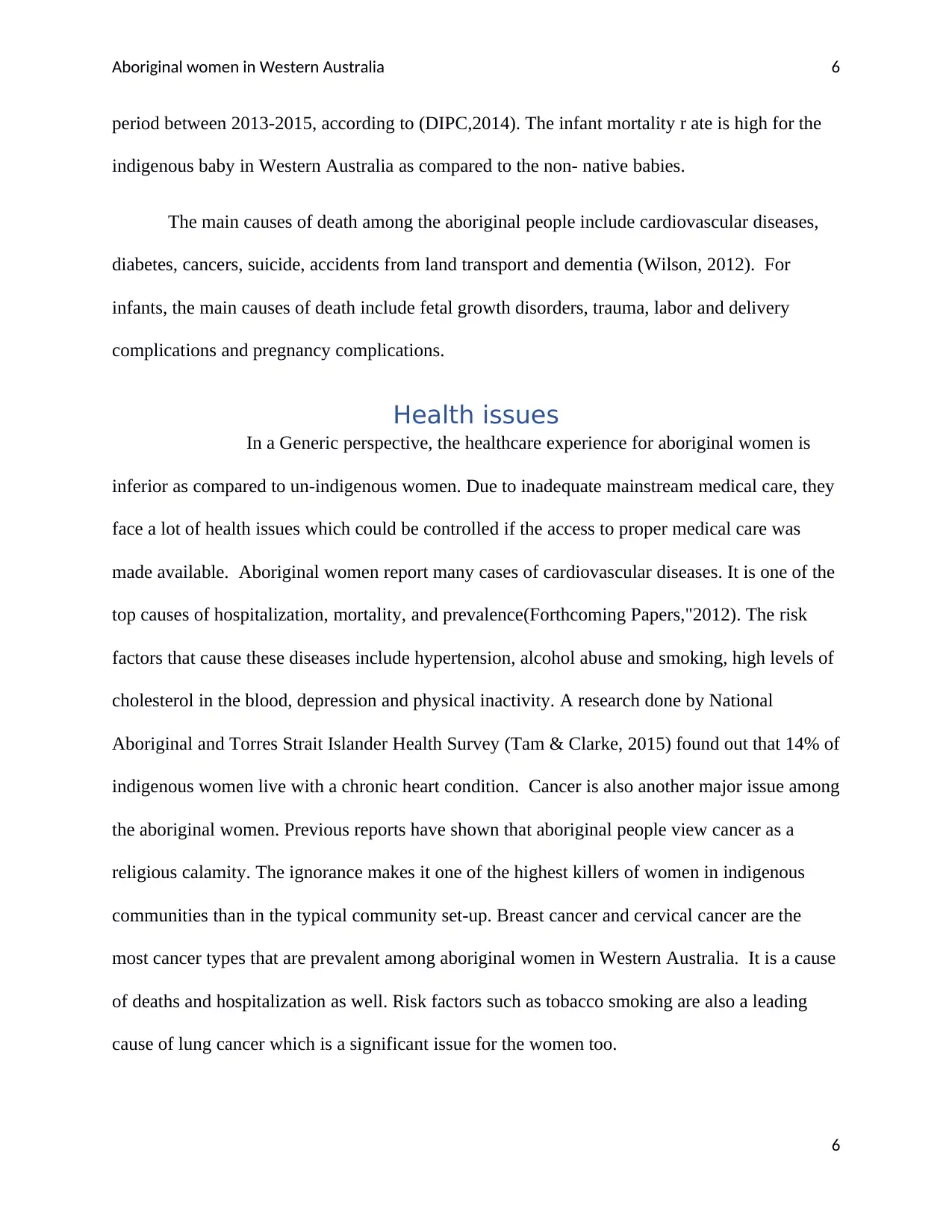
Aboriginal women in Western Australia 6
period between 2013-2015, according to (DIPC,2014). The infant mortality r ate is high for the
indigenous baby in Western Australia as compared to the non- native babies.
The main causes of death among the aboriginal people include cardiovascular diseases,
diabetes, cancers, suicide, accidents from land transport and dementia (Wilson, 2012). For
infants, the main causes of death include fetal growth disorders, trauma, labor and delivery
complications and pregnancy complications.
Health issues
In a Generic perspective, the healthcare experience for aboriginal women is
inferior as compared to un-indigenous women. Due to inadequate mainstream medical care, they
face a lot of health issues which could be controlled if the access to proper medical care was
made available. Aboriginal women report many cases of cardiovascular diseases. It is one of the
top causes of hospitalization, mortality, and prevalence(Forthcoming Papers,"2012). The risk
factors that cause these diseases include hypertension, alcohol abuse and smoking, high levels of
cholesterol in the blood, depression and physical inactivity. A research done by National
Aboriginal and Torres Strait Islander Health Survey (Tam & Clarke, 2015) found out that 14% of
indigenous women live with a chronic heart condition. Cancer is also another major issue among
the aboriginal women. Previous reports have shown that aboriginal people view cancer as a
religious calamity. The ignorance makes it one of the highest killers of women in indigenous
communities than in the typical community set-up. Breast cancer and cervical cancer are the
most cancer types that are prevalent among aboriginal women in Western Australia. It is a cause
of deaths and hospitalization as well. Risk factors such as tobacco smoking are also a leading
cause of lung cancer which is a significant issue for the women too.
6
period between 2013-2015, according to (DIPC,2014). The infant mortality r ate is high for the
indigenous baby in Western Australia as compared to the non- native babies.
The main causes of death among the aboriginal people include cardiovascular diseases,
diabetes, cancers, suicide, accidents from land transport and dementia (Wilson, 2012). For
infants, the main causes of death include fetal growth disorders, trauma, labor and delivery
complications and pregnancy complications.
Health issues
In a Generic perspective, the healthcare experience for aboriginal women is
inferior as compared to un-indigenous women. Due to inadequate mainstream medical care, they
face a lot of health issues which could be controlled if the access to proper medical care was
made available. Aboriginal women report many cases of cardiovascular diseases. It is one of the
top causes of hospitalization, mortality, and prevalence(Forthcoming Papers,"2012). The risk
factors that cause these diseases include hypertension, alcohol abuse and smoking, high levels of
cholesterol in the blood, depression and physical inactivity. A research done by National
Aboriginal and Torres Strait Islander Health Survey (Tam & Clarke, 2015) found out that 14% of
indigenous women live with a chronic heart condition. Cancer is also another major issue among
the aboriginal women. Previous reports have shown that aboriginal people view cancer as a
religious calamity. The ignorance makes it one of the highest killers of women in indigenous
communities than in the typical community set-up. Breast cancer and cervical cancer are the
most cancer types that are prevalent among aboriginal women in Western Australia. It is a cause
of deaths and hospitalization as well. Risk factors such as tobacco smoking are also a leading
cause of lung cancer which is a significant issue for the women too.
6
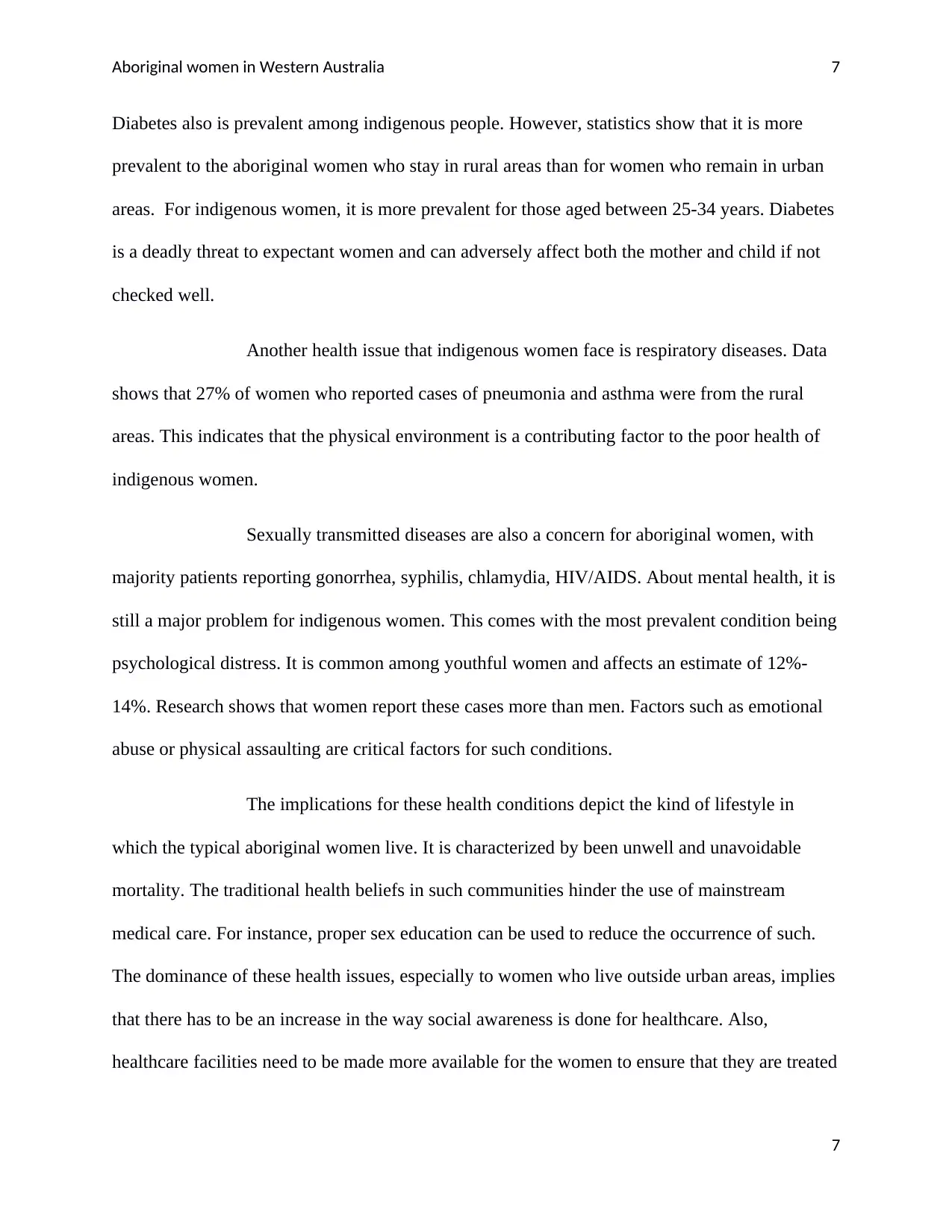
Aboriginal women in Western Australia 7
Diabetes also is prevalent among indigenous people. However, statistics show that it is more
prevalent to the aboriginal women who stay in rural areas than for women who remain in urban
areas. For indigenous women, it is more prevalent for those aged between 25-34 years. Diabetes
is a deadly threat to expectant women and can adversely affect both the mother and child if not
checked well.
Another health issue that indigenous women face is respiratory diseases. Data
shows that 27% of women who reported cases of pneumonia and asthma were from the rural
areas. This indicates that the physical environment is a contributing factor to the poor health of
indigenous women.
Sexually transmitted diseases are also a concern for aboriginal women, with
majority patients reporting gonorrhea, syphilis, chlamydia, HIV/AIDS. About mental health, it is
still a major problem for indigenous women. This comes with the most prevalent condition being
psychological distress. It is common among youthful women and affects an estimate of 12%-
14%. Research shows that women report these cases more than men. Factors such as emotional
abuse or physical assaulting are critical factors for such conditions.
The implications for these health conditions depict the kind of lifestyle in
which the typical aboriginal women live. It is characterized by been unwell and unavoidable
mortality. The traditional health beliefs in such communities hinder the use of mainstream
medical care. For instance, proper sex education can be used to reduce the occurrence of such.
The dominance of these health issues, especially to women who live outside urban areas, implies
that there has to be an increase in the way social awareness is done for healthcare. Also,
healthcare facilities need to be made more available for the women to ensure that they are treated
7
Diabetes also is prevalent among indigenous people. However, statistics show that it is more
prevalent to the aboriginal women who stay in rural areas than for women who remain in urban
areas. For indigenous women, it is more prevalent for those aged between 25-34 years. Diabetes
is a deadly threat to expectant women and can adversely affect both the mother and child if not
checked well.
Another health issue that indigenous women face is respiratory diseases. Data
shows that 27% of women who reported cases of pneumonia and asthma were from the rural
areas. This indicates that the physical environment is a contributing factor to the poor health of
indigenous women.
Sexually transmitted diseases are also a concern for aboriginal women, with
majority patients reporting gonorrhea, syphilis, chlamydia, HIV/AIDS. About mental health, it is
still a major problem for indigenous women. This comes with the most prevalent condition being
psychological distress. It is common among youthful women and affects an estimate of 12%-
14%. Research shows that women report these cases more than men. Factors such as emotional
abuse or physical assaulting are critical factors for such conditions.
The implications for these health conditions depict the kind of lifestyle in
which the typical aboriginal women live. It is characterized by been unwell and unavoidable
mortality. The traditional health beliefs in such communities hinder the use of mainstream
medical care. For instance, proper sex education can be used to reduce the occurrence of such.
The dominance of these health issues, especially to women who live outside urban areas, implies
that there has to be an increase in the way social awareness is done for healthcare. Also,
healthcare facilities need to be made more available for the women to ensure that they are treated
7
Secure Best Marks with AI Grader
Need help grading? Try our AI Grader for instant feedback on your assignments.
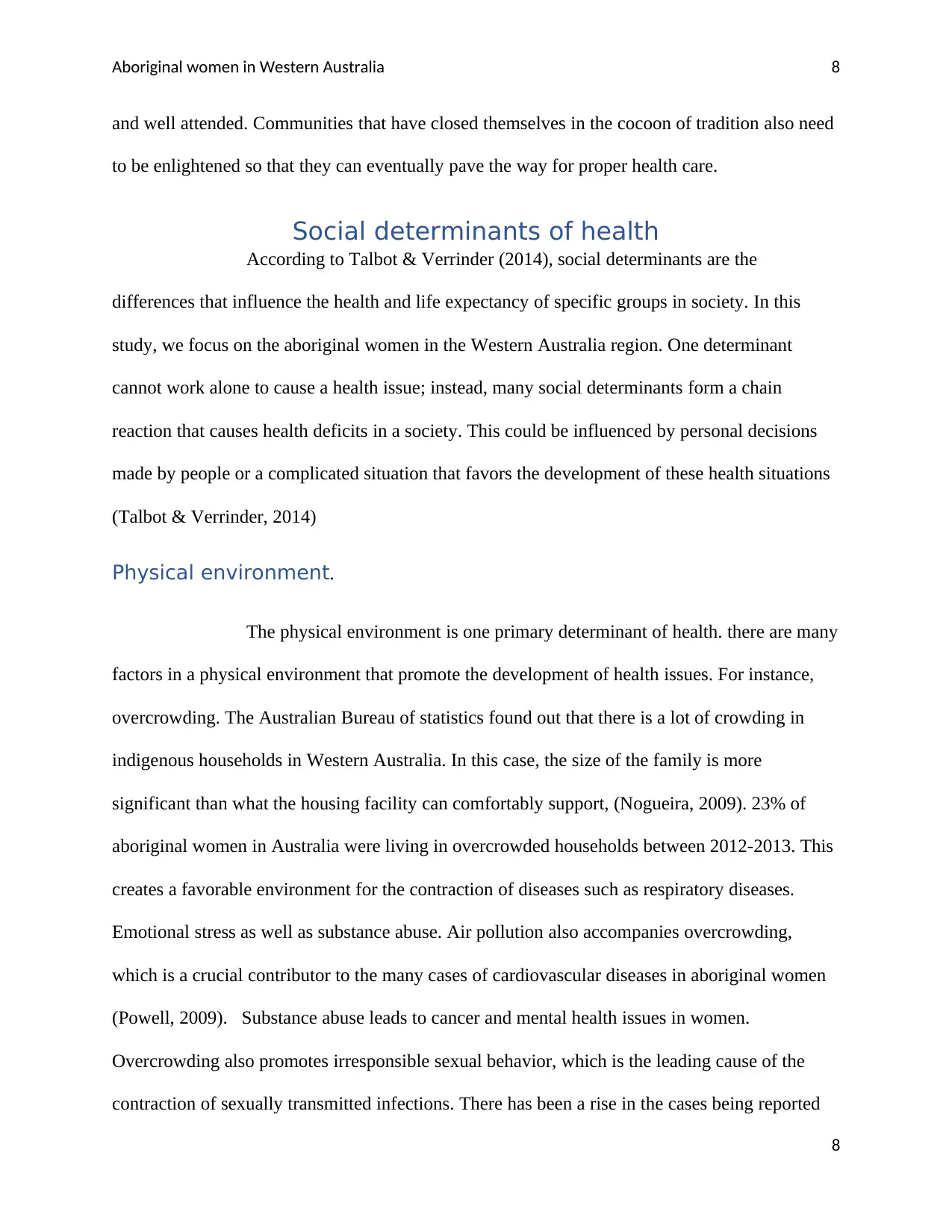
Aboriginal women in Western Australia 8
and well attended. Communities that have closed themselves in the cocoon of tradition also need
to be enlightened so that they can eventually pave the way for proper health care.
Social determinants of health
According to Talbot & Verrinder (2014), social determinants are the
differences that influence the health and life expectancy of specific groups in society. In this
study, we focus on the aboriginal women in the Western Australia region. One determinant
cannot work alone to cause a health issue; instead, many social determinants form a chain
reaction that causes health deficits in a society. This could be influenced by personal decisions
made by people or a complicated situation that favors the development of these health situations
(Talbot & Verrinder, 2014)
Physical environment.
The physical environment is one primary determinant of health. there are many
factors in a physical environment that promote the development of health issues. For instance,
overcrowding. The Australian Bureau of statistics found out that there is a lot of crowding in
indigenous households in Western Australia. In this case, the size of the family is more
significant than what the housing facility can comfortably support, (Nogueira, 2009). 23% of
aboriginal women in Australia were living in overcrowded households between 2012-2013. This
creates a favorable environment for the contraction of diseases such as respiratory diseases.
Emotional stress as well as substance abuse. Air pollution also accompanies overcrowding,
which is a crucial contributor to the many cases of cardiovascular diseases in aboriginal women
(Powell, 2009). Substance abuse leads to cancer and mental health issues in women.
Overcrowding also promotes irresponsible sexual behavior, which is the leading cause of the
contraction of sexually transmitted infections. There has been a rise in the cases being reported
8
and well attended. Communities that have closed themselves in the cocoon of tradition also need
to be enlightened so that they can eventually pave the way for proper health care.
Social determinants of health
According to Talbot & Verrinder (2014), social determinants are the
differences that influence the health and life expectancy of specific groups in society. In this
study, we focus on the aboriginal women in the Western Australia region. One determinant
cannot work alone to cause a health issue; instead, many social determinants form a chain
reaction that causes health deficits in a society. This could be influenced by personal decisions
made by people or a complicated situation that favors the development of these health situations
(Talbot & Verrinder, 2014)
Physical environment.
The physical environment is one primary determinant of health. there are many
factors in a physical environment that promote the development of health issues. For instance,
overcrowding. The Australian Bureau of statistics found out that there is a lot of crowding in
indigenous households in Western Australia. In this case, the size of the family is more
significant than what the housing facility can comfortably support, (Nogueira, 2009). 23% of
aboriginal women in Australia were living in overcrowded households between 2012-2013. This
creates a favorable environment for the contraction of diseases such as respiratory diseases.
Emotional stress as well as substance abuse. Air pollution also accompanies overcrowding,
which is a crucial contributor to the many cases of cardiovascular diseases in aboriginal women
(Powell, 2009). Substance abuse leads to cancer and mental health issues in women.
Overcrowding also promotes irresponsible sexual behavior, which is the leading cause of the
contraction of sexually transmitted infections. There has been a rise in the cases being reported
8
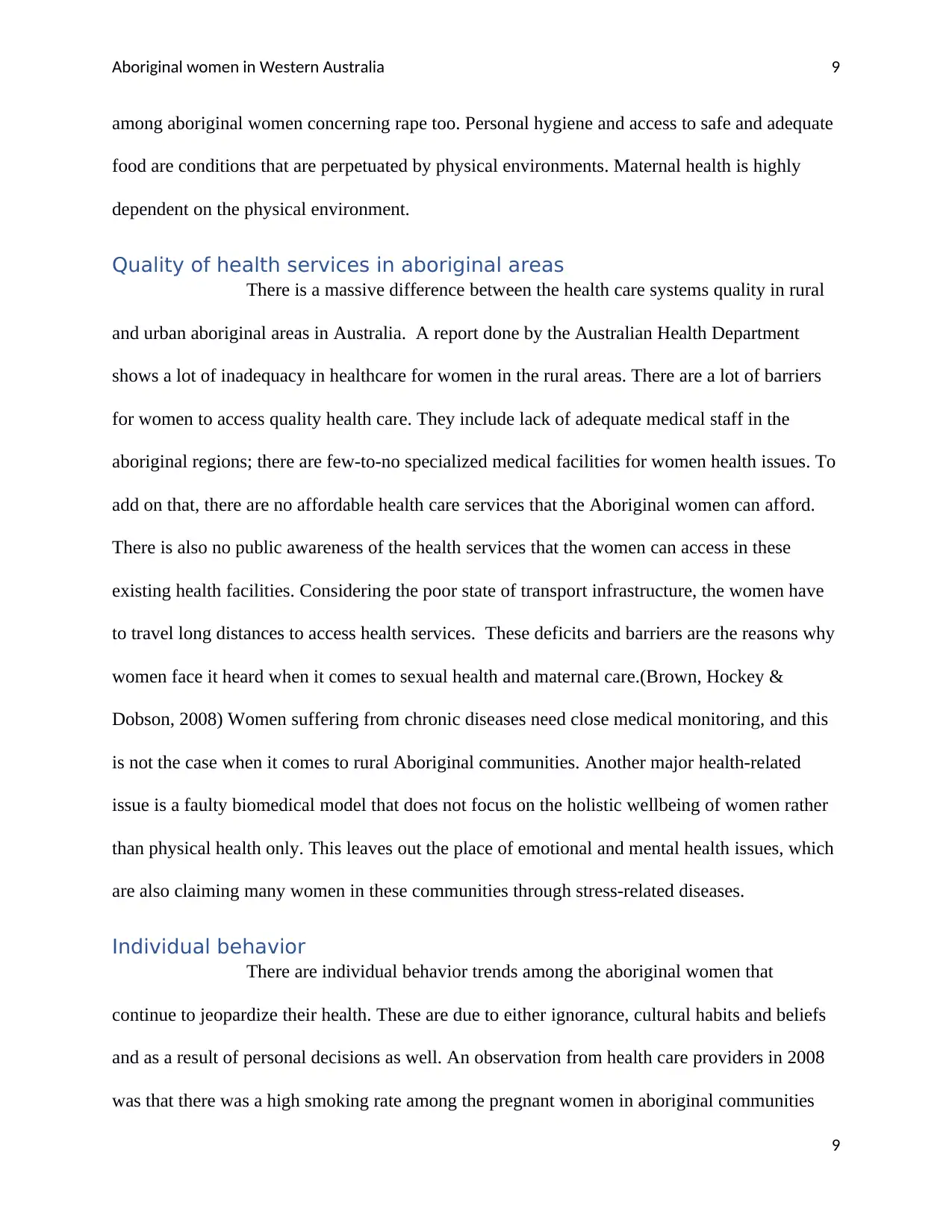
Aboriginal women in Western Australia 9
among aboriginal women concerning rape too. Personal hygiene and access to safe and adequate
food are conditions that are perpetuated by physical environments. Maternal health is highly
dependent on the physical environment.
Quality of health services in aboriginal areas
There is a massive difference between the health care systems quality in rural
and urban aboriginal areas in Australia. A report done by the Australian Health Department
shows a lot of inadequacy in healthcare for women in the rural areas. There are a lot of barriers
for women to access quality health care. They include lack of adequate medical staff in the
aboriginal regions; there are few-to-no specialized medical facilities for women health issues. To
add on that, there are no affordable health care services that the Aboriginal women can afford.
There is also no public awareness of the health services that the women can access in these
existing health facilities. Considering the poor state of transport infrastructure, the women have
to travel long distances to access health services. These deficits and barriers are the reasons why
women face it heard when it comes to sexual health and maternal care.(Brown, Hockey &
Dobson, 2008) Women suffering from chronic diseases need close medical monitoring, and this
is not the case when it comes to rural Aboriginal communities. Another major health-related
issue is a faulty biomedical model that does not focus on the holistic wellbeing of women rather
than physical health only. This leaves out the place of emotional and mental health issues, which
are also claiming many women in these communities through stress-related diseases.
Individual behavior
There are individual behavior trends among the aboriginal women that
continue to jeopardize their health. These are due to either ignorance, cultural habits and beliefs
and as a result of personal decisions as well. An observation from health care providers in 2008
was that there was a high smoking rate among the pregnant women in aboriginal communities
9
among aboriginal women concerning rape too. Personal hygiene and access to safe and adequate
food are conditions that are perpetuated by physical environments. Maternal health is highly
dependent on the physical environment.
Quality of health services in aboriginal areas
There is a massive difference between the health care systems quality in rural
and urban aboriginal areas in Australia. A report done by the Australian Health Department
shows a lot of inadequacy in healthcare for women in the rural areas. There are a lot of barriers
for women to access quality health care. They include lack of adequate medical staff in the
aboriginal regions; there are few-to-no specialized medical facilities for women health issues. To
add on that, there are no affordable health care services that the Aboriginal women can afford.
There is also no public awareness of the health services that the women can access in these
existing health facilities. Considering the poor state of transport infrastructure, the women have
to travel long distances to access health services. These deficits and barriers are the reasons why
women face it heard when it comes to sexual health and maternal care.(Brown, Hockey &
Dobson, 2008) Women suffering from chronic diseases need close medical monitoring, and this
is not the case when it comes to rural Aboriginal communities. Another major health-related
issue is a faulty biomedical model that does not focus on the holistic wellbeing of women rather
than physical health only. This leaves out the place of emotional and mental health issues, which
are also claiming many women in these communities through stress-related diseases.
Individual behavior
There are individual behavior trends among the aboriginal women that
continue to jeopardize their health. These are due to either ignorance, cultural habits and beliefs
and as a result of personal decisions as well. An observation from health care providers in 2008
was that there was a high smoking rate among the pregnant women in aboriginal communities
9
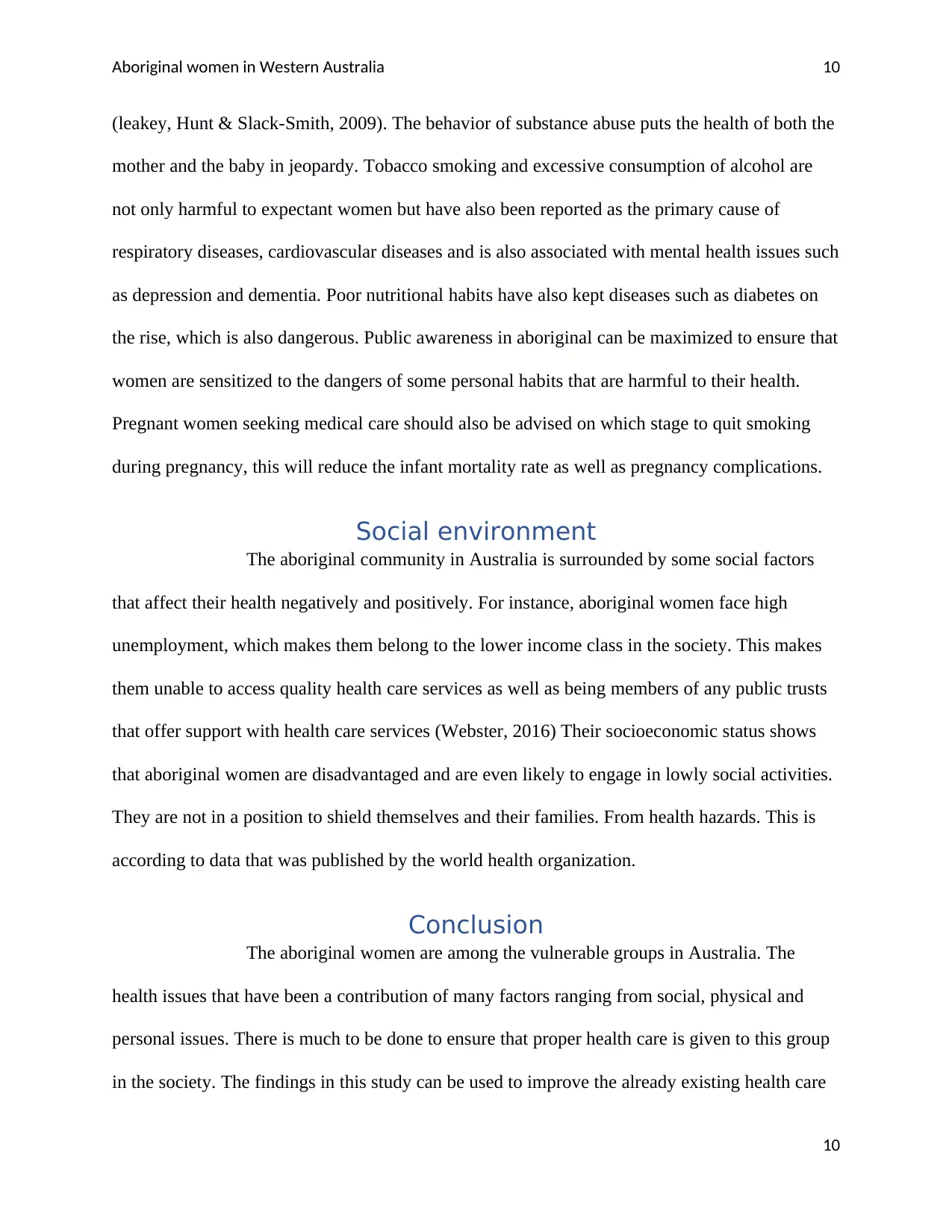
Aboriginal women in Western Australia 10
(leakey, Hunt & Slack-Smith, 2009). The behavior of substance abuse puts the health of both the
mother and the baby in jeopardy. Tobacco smoking and excessive consumption of alcohol are
not only harmful to expectant women but have also been reported as the primary cause of
respiratory diseases, cardiovascular diseases and is also associated with mental health issues such
as depression and dementia. Poor nutritional habits have also kept diseases such as diabetes on
the rise, which is also dangerous. Public awareness in aboriginal can be maximized to ensure that
women are sensitized to the dangers of some personal habits that are harmful to their health.
Pregnant women seeking medical care should also be advised on which stage to quit smoking
during pregnancy, this will reduce the infant mortality rate as well as pregnancy complications.
Social environment
The aboriginal community in Australia is surrounded by some social factors
that affect their health negatively and positively. For instance, aboriginal women face high
unemployment, which makes them belong to the lower income class in the society. This makes
them unable to access quality health care services as well as being members of any public trusts
that offer support with health care services (Webster, 2016) Their socioeconomic status shows
that aboriginal women are disadvantaged and are even likely to engage in lowly social activities.
They are not in a position to shield themselves and their families. From health hazards. This is
according to data that was published by the world health organization.
Conclusion
The aboriginal women are among the vulnerable groups in Australia. The
health issues that have been a contribution of many factors ranging from social, physical and
personal issues. There is much to be done to ensure that proper health care is given to this group
in the society. The findings in this study can be used to improve the already existing health care
10
(leakey, Hunt & Slack-Smith, 2009). The behavior of substance abuse puts the health of both the
mother and the baby in jeopardy. Tobacco smoking and excessive consumption of alcohol are
not only harmful to expectant women but have also been reported as the primary cause of
respiratory diseases, cardiovascular diseases and is also associated with mental health issues such
as depression and dementia. Poor nutritional habits have also kept diseases such as diabetes on
the rise, which is also dangerous. Public awareness in aboriginal can be maximized to ensure that
women are sensitized to the dangers of some personal habits that are harmful to their health.
Pregnant women seeking medical care should also be advised on which stage to quit smoking
during pregnancy, this will reduce the infant mortality rate as well as pregnancy complications.
Social environment
The aboriginal community in Australia is surrounded by some social factors
that affect their health negatively and positively. For instance, aboriginal women face high
unemployment, which makes them belong to the lower income class in the society. This makes
them unable to access quality health care services as well as being members of any public trusts
that offer support with health care services (Webster, 2016) Their socioeconomic status shows
that aboriginal women are disadvantaged and are even likely to engage in lowly social activities.
They are not in a position to shield themselves and their families. From health hazards. This is
according to data that was published by the world health organization.
Conclusion
The aboriginal women are among the vulnerable groups in Australia. The
health issues that have been a contribution of many factors ranging from social, physical and
personal issues. There is much to be done to ensure that proper health care is given to this group
in the society. The findings in this study can be used to improve the already existing health care
10
Paraphrase This Document
Need a fresh take? Get an instant paraphrase of this document with our AI Paraphraser
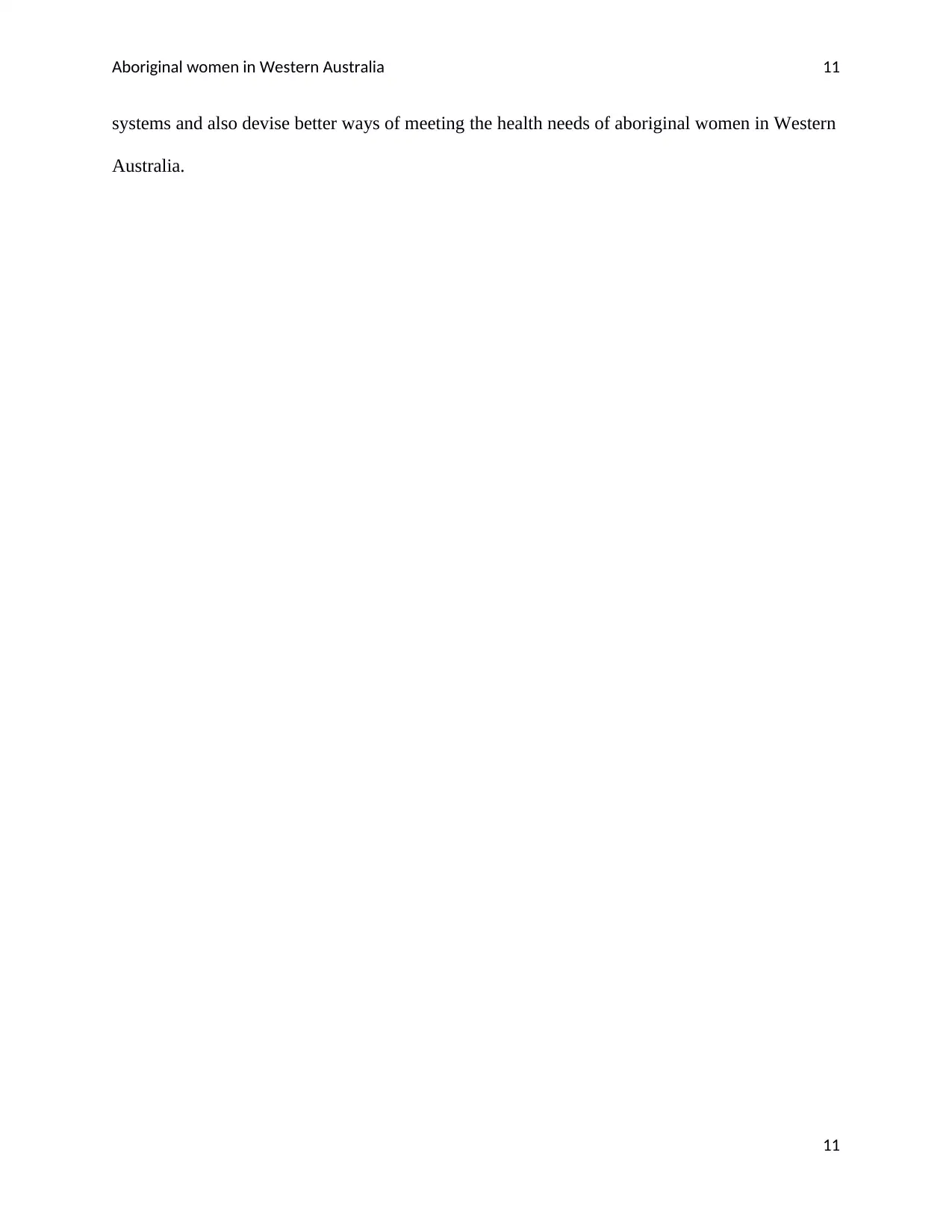
Aboriginal women in Western Australia 11
systems and also devise better ways of meeting the health needs of aboriginal women in Western
Australia.
11
systems and also devise better ways of meeting the health needs of aboriginal women in Western
Australia.
11
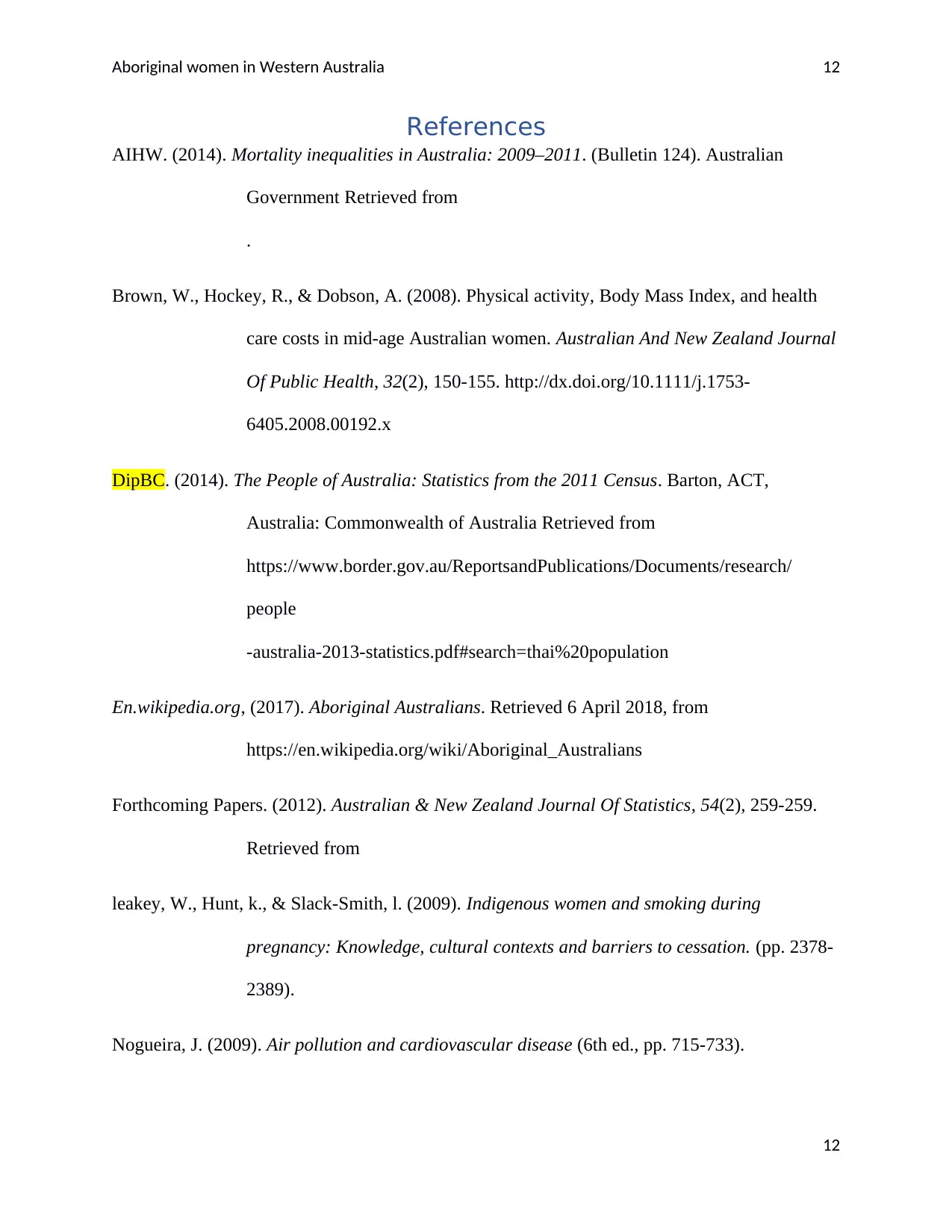
Aboriginal women in Western Australia 12
References
AIHW. (2014). Mortality inequalities in Australia: 2009–2011. (Bulletin 124). Australian
Government Retrieved from
.
Brown, W., Hockey, R., & Dobson, A. (2008). Physical activity, Body Mass Index, and health
care costs in mid-age Australian women. Australian And New Zealand Journal
Of Public Health, 32(2), 150-155. http://dx.doi.org/10.1111/j.1753-
6405.2008.00192.x
DipBC. (2014). The People of Australia: Statistics from the 2011 Census. Barton, ACT,
Australia: Commonwealth of Australia Retrieved from
https://www.border.gov.au/ReportsandPublications/Documents/research/
people
-australia-2013-statistics.pdf#search=thai%20population
En.wikipedia.org, (2017). Aboriginal Australians. Retrieved 6 April 2018, from
https://en.wikipedia.org/wiki/Aboriginal_Australians
Forthcoming Papers. (2012). Australian & New Zealand Journal Of Statistics, 54(2), 259-259.
Retrieved from
leakey, W., Hunt, k., & Slack-Smith, l. (2009). Indigenous women and smoking during
pregnancy: Knowledge, cultural contexts and barriers to cessation. (pp. 2378-
2389).
Nogueira, J. (2009). Air pollution and cardiovascular disease (6th ed., pp. 715-733).
12
References
AIHW. (2014). Mortality inequalities in Australia: 2009–2011. (Bulletin 124). Australian
Government Retrieved from
.
Brown, W., Hockey, R., & Dobson, A. (2008). Physical activity, Body Mass Index, and health
care costs in mid-age Australian women. Australian And New Zealand Journal
Of Public Health, 32(2), 150-155. http://dx.doi.org/10.1111/j.1753-
6405.2008.00192.x
DipBC. (2014). The People of Australia: Statistics from the 2011 Census. Barton, ACT,
Australia: Commonwealth of Australia Retrieved from
https://www.border.gov.au/ReportsandPublications/Documents/research/
people
-australia-2013-statistics.pdf#search=thai%20population
En.wikipedia.org, (2017). Aboriginal Australians. Retrieved 6 April 2018, from
https://en.wikipedia.org/wiki/Aboriginal_Australians
Forthcoming Papers. (2012). Australian & New Zealand Journal Of Statistics, 54(2), 259-259.
Retrieved from
leakey, W., Hunt, k., & Slack-Smith, l. (2009). Indigenous women and smoking during
pregnancy: Knowledge, cultural contexts and barriers to cessation. (pp. 2378-
2389).
Nogueira, J. (2009). Air pollution and cardiovascular disease (6th ed., pp. 715-733).
12
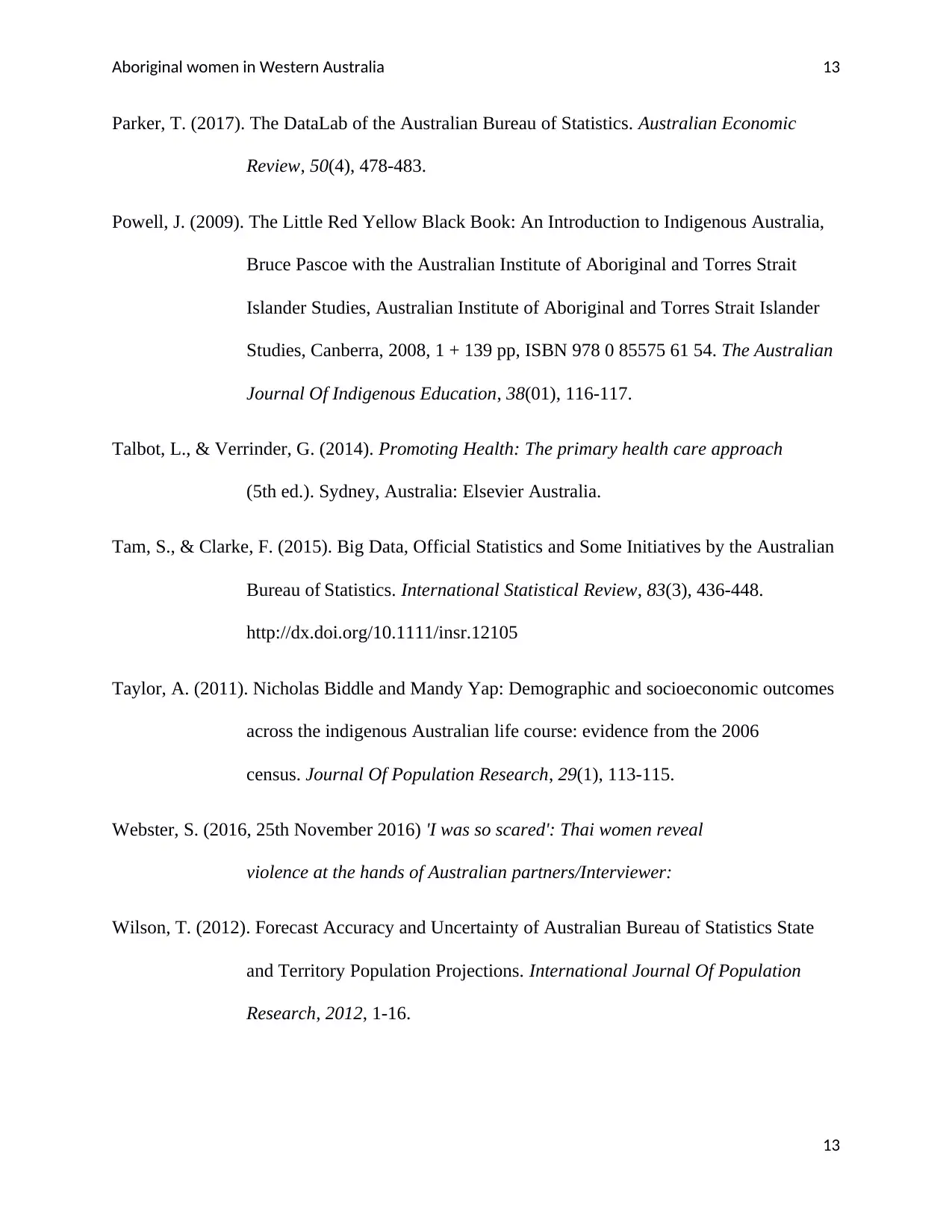
Aboriginal women in Western Australia 13
Parker, T. (2017). The DataLab of the Australian Bureau of Statistics. Australian Economic
Review, 50(4), 478-483.
Powell, J. (2009). The Little Red Yellow Black Book: An Introduction to Indigenous Australia,
Bruce Pascoe with the Australian Institute of Aboriginal and Torres Strait
Islander Studies, Australian Institute of Aboriginal and Torres Strait Islander
Studies, Canberra, 2008, 1 + 139 pp, ISBN 978 0 85575 61 54. The Australian
Journal Of Indigenous Education, 38(01), 116-117.
Talbot, L., & Verrinder, G. (2014). Promoting Health: The primary health care approach
(5th ed.). Sydney, Australia: Elsevier Australia.
Tam, S., & Clarke, F. (2015). Big Data, Official Statistics and Some Initiatives by the Australian
Bureau of Statistics. International Statistical Review, 83(3), 436-448.
http://dx.doi.org/10.1111/insr.12105
Taylor, A. (2011). Nicholas Biddle and Mandy Yap: Demographic and socioeconomic outcomes
across the indigenous Australian life course: evidence from the 2006
census. Journal Of Population Research, 29(1), 113-115.
Webster, S. (2016, 25th November 2016) 'I was so scared': Thai women reveal
violence at the hands of Australian partners/Interviewer:
Wilson, T. (2012). Forecast Accuracy and Uncertainty of Australian Bureau of Statistics State
and Territory Population Projections. International Journal Of Population
Research, 2012, 1-16.
13
Parker, T. (2017). The DataLab of the Australian Bureau of Statistics. Australian Economic
Review, 50(4), 478-483.
Powell, J. (2009). The Little Red Yellow Black Book: An Introduction to Indigenous Australia,
Bruce Pascoe with the Australian Institute of Aboriginal and Torres Strait
Islander Studies, Australian Institute of Aboriginal and Torres Strait Islander
Studies, Canberra, 2008, 1 + 139 pp, ISBN 978 0 85575 61 54. The Australian
Journal Of Indigenous Education, 38(01), 116-117.
Talbot, L., & Verrinder, G. (2014). Promoting Health: The primary health care approach
(5th ed.). Sydney, Australia: Elsevier Australia.
Tam, S., & Clarke, F. (2015). Big Data, Official Statistics and Some Initiatives by the Australian
Bureau of Statistics. International Statistical Review, 83(3), 436-448.
http://dx.doi.org/10.1111/insr.12105
Taylor, A. (2011). Nicholas Biddle and Mandy Yap: Demographic and socioeconomic outcomes
across the indigenous Australian life course: evidence from the 2006
census. Journal Of Population Research, 29(1), 113-115.
Webster, S. (2016, 25th November 2016) 'I was so scared': Thai women reveal
violence at the hands of Australian partners/Interviewer:
Wilson, T. (2012). Forecast Accuracy and Uncertainty of Australian Bureau of Statistics State
and Territory Population Projections. International Journal Of Population
Research, 2012, 1-16.
13
Secure Best Marks with AI Grader
Need help grading? Try our AI Grader for instant feedback on your assignments.
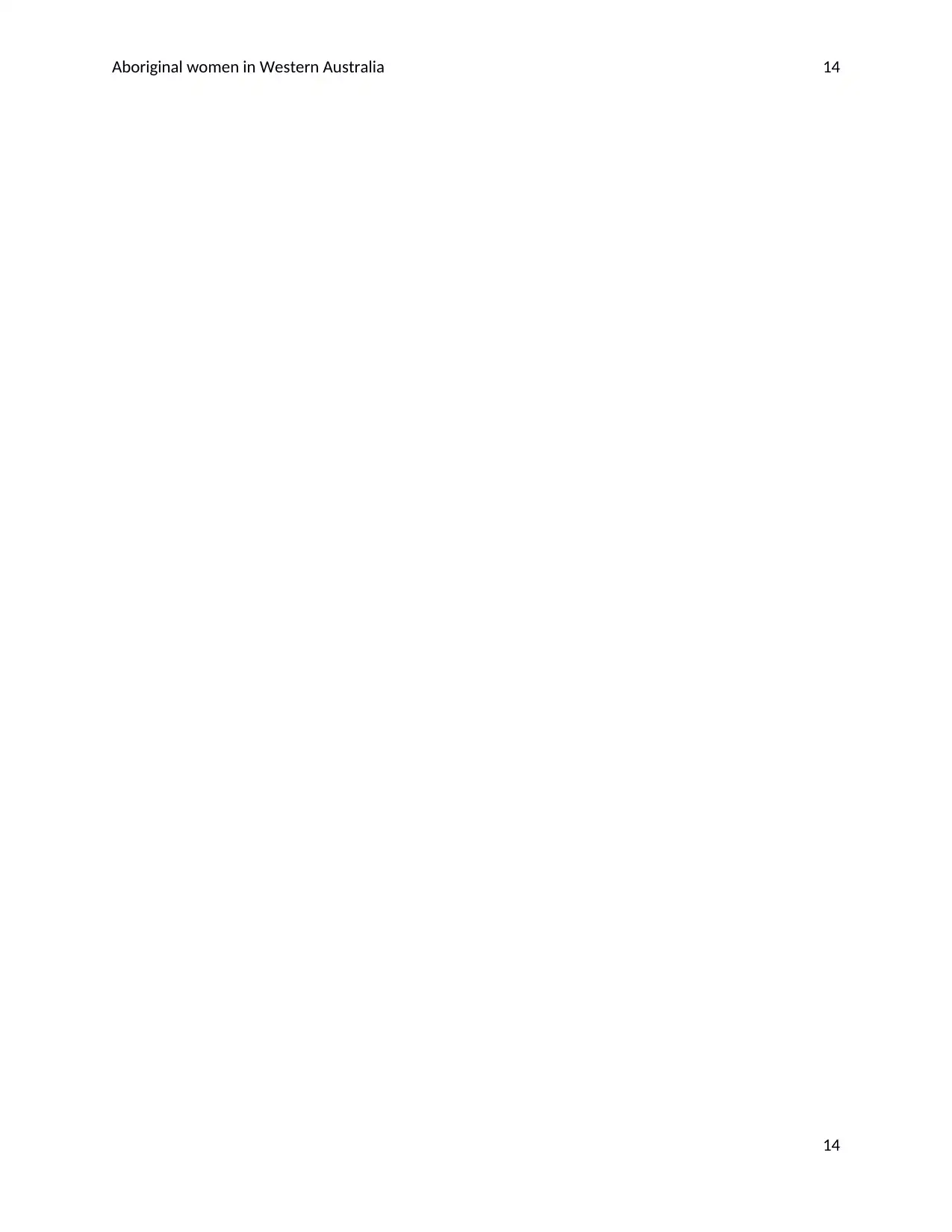
Aboriginal women in Western Australia 14
14
14
1 out of 14
![[object Object]](/_next/static/media/star-bottom.7253800d.svg)





